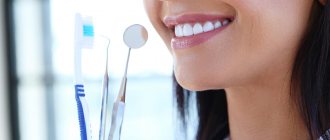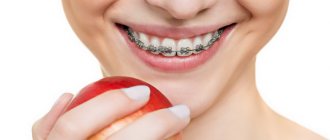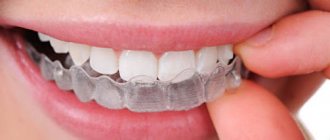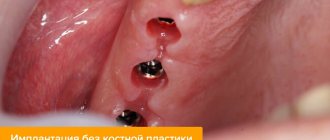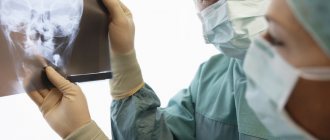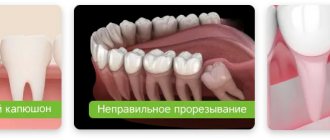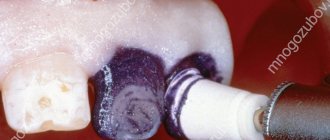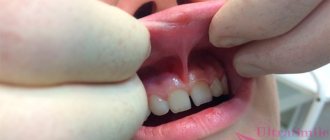September 27, 2018
What should people do if their smile beauty, quality of life and health suffer due to natural or acquired anomalies? For example, due to insufficient distance between the teeth and the lip, due to strong muscle tension in this area, due to the development of periodontitis and periodontal disease, a loss of mucous tissue occurs. This cannot be done without correcting defects. And this can be done with the help of a plastic surgery such as vestibuloplasty. The editors of the UltraSmile.ru portal propose to talk about its types, features, difficulties, and rehabilitation period today.
What is vestibuloplasty?
We hope that after reading this material, people who need surgery, but are afraid of it, will make the right decision.
What is vestibuloplasty and who is it indicated for?
Vestibuloplasty is an operation to correct the oral mucosa. Most often, it is performed when a person has a natural anomaly - a small vestibule of the oral cavity. The problem may occur in the upper or lower jaw. Localized between the lip and teeth.
In fact, with such a pathology, the patient is left with a very small distance between the lip and teeth, which causes constant tension in the gums, tone of muscles and ligaments occurs in the process of communication, nutrition, and life, and limited lip mobility appears. Tissue tension or lack thereof interferes with the normal functioning of the maxillofacial apparatus. And this, in turn, can lead to a number of dental diseases and the inability to lead a full lifestyle.
When there is a need for surgery:
- treatment by a speech therapist: in patients with such an anomaly, diction and articulation are often impaired, and without surgery, classes and exercises will not lead to the desired result,
- inflammation of periodontal tissue: we are talking about diseases such as periodontitis and periodontal disease. The tension of the ligaments between the lip and teeth leads to impaired blood circulation and nutrition of the mucous membrane, and the bone tissue of the jaw does not receive sufficient nutrition. The gums atrophy, periodontal pockets appear, where bacteria penetrate. As a result, the tooth roots are exposed, and the teeth become mobile,
Periodontitis - indication for surgery - before correcting the bite at the orthodontist: pathology is almost always accompanied by an incorrect bite, underdevelopment of the upper or lower jaw, and dental defects. And in order for the correction to be successful, you must first perform vestibuloplasty,
- before prosthetics: this measure will allow you to secure the prosthesis after treatment and then use it without pain,
- before implantation: it is important to carry out the procedure before implantation if the muscles are attached too high to the alveolar process,
- prevention of gum recession,
- aesthetic defect.
There are a number of contraindications to the operation: blood diseases (cancer, hemophilia), cerebral palsy, osteomyelitis, mental disorders, drug addiction and alcoholism, chronic inflammatory processes on the mucous membrane, oncology and multiple caries.
What the operation allows to achieve: the tension of the gums and ligaments is reduced, the vestibule of the mouth is deepened, the patient gets rid of problems with health, speech, and nutrition.
What is interesting is the fact that vestibuloplasty can be performed in different ways. The decision on how the procedure will be carried out can only be made by a doctor based on the medical history, age and individual characteristics of the patient.
Contraindications to the procedure
Vestibuloplasty is not performed on patients who suffer from:
- severe forms of diabetes;
- pathologies of blood and hematopoiesis (leukemia, hemophilia), blood cancer;
- complicated and multiple dental caries.
Also, vestibuloplasty is contraindicated in cases of cerebral vascular damage, recent radiation exposure to the head and neck area, frequent relapses of chronic inflammation of the oral mucosa, a tendency to form keloid scars, the presence of oncology, and mental disorders.
Operation Clark
This method is one of the simplest. It is used mainly to correct defects in the upper jaw. The procedure is performed under anesthesia, most often under infiltration, so there is no need to be afraid of pain during the operation.
During the procedure, the doctor cuts through the tissue between the mucous membrane of the inner lip and gum. Then the specialist peels off or lifts the mucous membrane. Then it displaces the tendons and muscles located underneath it to the required depth. Next, the mucosa is fixed to the periosteum by suturing.
This is what the Clark operation looks like
Important!
Six hours before surgery, avoid eating solid foods. Strictly follow all doctor's recommendations: painkillers, alcohol or sedatives taken at home can adversely affect your body and the effect of anesthetics.
PREPARATION FOR OPERATION
To successfully undergo direct surgical intervention, dentists recommend following the following rules:
- undergo preliminary x-ray diagnostics of the operated cavity;
- Do not use any medications, especially painkillers. If you need to constantly take any medications, indicate this to the doctor performing the operation;
- solid food is excluded 8-10 hours before surgery;
- it is necessary to perform proper hygiene procedures to remove accumulated plaque;
- Before surgery, check with your doctor about any concerns you may have. This will help get rid of excessive anxiety and fear, and will allow you to have a positive psychological attitude towards the operation. In this case, the period of rehabilitation and recovery will take place in the shortest possible time, with minimal discomfort.
Edlan-Meicher operation
The procedure is very popular today. Doctors use it more often than other options, because... the operation provides a successful positive result. Indicated for correction of the lower jaw mucosa.
The peculiarity of this type of vestibuloplasty is that the doctor first makes an incision on the mucous side of the lip along the entire length of the jaw bone, as in the photo. Next, he forms an area for a new vestibule of the oral cavity, moves submucosal tissues, muscles and tendons to this area. Then he sews the separated area of the mucosa together with the periosteum and protects the damaged area with a protective bandage.
Previously, gauze cloth soaked in iodine or other disinfectants acted as such a protective bandage. Today, experts give preference, for example, to Diplen Denta films. The films are impregnated with lidocaine, which allows the patient to easily endure the rehabilitation period and not experience pain. And also chlorhexidine, which eliminates the risk of infection entering the wound.
The photo shows the Edlan-Meicher operation
Vestibuloplasty in Moscow: price
The cost of the operation depends on the chosen technique, the equipment used, the type of anesthesia, and additional services. Prices from 8,000 to 14,000 rubles and above. The procedure performed using a laser will be more expensive than using a scalpel. The cost of anesthesia is calculated separately.
The FamilySmile clinic has verified prices and positive customer reviews. The cost of treatment is agreed upon with the patient before the start of the procedures. We employ highly qualified surgeons. They are proficient in various surgical techniques, including gentle tunnel correction for children and adults. We guarantee high results and no complications.
You can make an appointment with a doctor by phone.
Operation according to Glickman
Vestibuloplasty according to Glickman is considered one of the most universal methods. It can be performed in various clinical cases, both on a small limited area and on a large area of damaged mucosa.
Interesting!
The small vestibule of the oral cavity is not always a congenital pathology. The defect can also be acquired during life under the influence of traumatic factors: burns of the mucous membrane, improper scarring of tissue as a result of surgical interventions.
USING LASER IN VESTIBULOPLASTY
Vestibuloplasty using laser technologies is the most promising, innovative, minimally invasive surgical intervention. Using a laser, you can clearly predict the timing and results of plastic surgery, and clearly organize the entire treatment process.
Advantages of using laser in surgery:
- minimal impact on the nerve endings of the cut tissues, little pain;
- rapid postoperative tissue regeneration;
- precise and non-bleeding incision;
- burns of surrounding tissues are excluded, hypersensitivity of tooth enamel is not caused;
- prevention of disturbances in microcirculation processes;
- improved marginal fit of contacting surfaces;
- the possibility of infection of the operated tissues is excluded;
- destruction of pathological microflora, exclusion of purulent-destructive inflammatory processes;
- stimulation of tissue regeneration, absence of scar growths.
For vestibuloplasty, the following types of lasers are used:
- neodymium Nd:YAG laser - with good absorption in pigmented tissues (hemoglabin, melanin). Capable of cutting surfaces in continuous and pulse modes. The radiation is supplied via a flexible light guide;
- argon - with high speed and degree of polymerization of light-curing materials. When used, bleeding is effectively prevented and almost completely stopped;
- diode semiconductor laser - with good hemostatic effect and absorption by pigmented tissues. It has compact overall dimensions, is easily applicable in clinical settings, and has an effect that stimulates tissue regeneration.
Tunnel method
In this case, the specialist makes not one large and deep incision parallel to the curve of the jaw bone, but several small incisions in different places - most often there are three. Thanks to this approach, the procedure is considered the least traumatic and minimally invasive, and involves rapid healing of wound surfaces. The method can be used to correct a defect in any jaw. And due to minimal trauma, it is often performed on children.
This is what tunnel vestibuloplasty looks like
Interesting!
As studies show1, it was the operations performed by the tunnel method that patients tolerated most easily.
They, compared to those for whom the procedure was performed in a different way, only in 40% of cases complained of pain and swelling of the tissues during the rehabilitation period. While with four other techniques, complaints were received in 100% of all cases, and tissue healing took an average of 3-7 days longer. Any of the listed types of vestibuloplasty can be performed either using a conventional scalpel or using laser equipment. The second option is more preferable, as it allows you to minimize any surgical and postoperative complications. The use of a laser also contributes to excellent sterilization of tissues, their rapid regeneration and healing: targeted impact during the procedure helps make it virtually painless.
The effectiveness of lasers today has been confirmed by many successful operations both in the field of treatment of teeth and gums, and in the field of dental restoration using laser implantation.
Laser is one of the safest instruments for surgery today.
How does healing proceed after vestibuloplasty?
The rehabilitation period lasts on average 2 weeks. During this time, you should not overheat the body, brush your teeth with hard brushes or eat solid foods. To relieve symptoms and speed up the regeneration process, you must follow your doctor's advice.
Rules for the rehabilitation period:
- rinse your mouth with antiseptics after each meal;
- brush your teeth with a soft brush from 3 to 4 days (not allowed in the first few days);
- eat soft, pureed or liquid foods, exclude spicy, sour, dairy products, and solid foods;
- give up alcohol and cigarettes, as this impairs wound healing;
- performing a massage on the outer side of the lip with your fingertips, special exercises - pouting the lips, lightly massaging the operated area with the tip of the tongue;
- visiting a doctor to monitor the process of tissue restoration.
If everything is done correctly, then after two weeks you can forget about the unpleasant procedure.
What complications can there be?
Vestibuloplasty is considered a relatively simple operation, which is practically not accompanied by serious complications. However, they cannot be excluded, especially if the patient neglects the doctor’s recommendations during the rehabilitation period. Ideally, consequences such as tissue bleeding, swelling and pain reach their peak on the second day after surgery, then begin to subside. Sometimes, negligence on the part of the patient can lead to the formation of scars, purulent inflammations and fistulas, and relapse of the disease (the probability of complications is only 0.1 percent).
“I needed vestibuloplasty in order to properly fix the prosthesis; there was not enough space. The procedure was very difficult for me, although there were no special complications, but the rehabilitation period was extremely long and protracted. The discomfort continued for 8 months. But what’s most unpleasant is that removable dentures didn’t bring much joy after that either. It would be better to immediately decide on implantation, as the doctor advised, a prosthesis on implants takes up much less space, and there would be no need to operate on me on such a large scale.”
Ekaterina Mikhailovna, Moscow, from correspondence on forums
HOW TO TREAT ARISING COMPLICATIONS
Ignoring rehabilitation recommendations can lead to the occurrence of certain pathologies, namely:
- severe bleeding. To eliminate it, you should use hemostatic tablets, make cold applications with liquids for better blood clotting;
- the appearance of ligature fistulas. May be caused by individual intolerance to suture material. In this case, you should consult a doctor to prescribe healing medications;
- excessive swelling. It may be an individual feature; as a rule, it completely disappears within 3-5 days from the date of surgery;
- loss of sensation in the operated area. The norm is that the period of complete restoration of sensitivity can range from six months to 9 months. Physiotherapy (hydromassage, paraffin baths) and rehabilitation exercises help speed up the process.
How to survive the rehabilitation period
It is natural that after the operation you will feel pain. And this is a completely correct reaction of the body to intervention. To ensure that swelling, pain and other unpleasant phenomena leave you as quickly as possible after the procedure, try to follow these recommendations:
- eat right: exclude salty, sour, hot, spicy foods from your diet. Food should have a soft, puree-like consistency. Refrain from taking dairy drinks and products, they provoke strong plaque formation in the oral cavity, and you must be very careful with hygiene procedures during the rehabilitation period,
- Maintain oral hygiene: you can fully begin it only 3-4 days after vestibuloplasty. This should be done with a brush with soft bristles. It is important to use mouthwash after every snack.
- do gymnastics: to quickly restore the sensitivity of muscles and tissues, normalize speech, improve the functionality of organs, to rehabilitate faster, perform special exercises.
Gymnastics will help consolidate the results of treatment.
Some people with defects in the oral cavity continue to doubt the need for a procedure such as vestibuloplasty. However, if this is not done, you may encounter the development of periodontitis, which can ultimately lead to complete loss of teeth. Here you will have to think about restoring your teeth using removable dentures or implants.
Notice
: Undefined variable: post_id in
/home/c/ch75405/public_html/wp-content/themes/UltraSmile/single-item.php
on line
45 Notice
: Undefined variable: full in
/home/c/ch75405/public_html/wp-content /themes/UltraSmile/single-item.php
on line
46
Rate this article:
( 3 ratings, average: 3.67 out of 5)
gum disease
- Akhmerov V.D. Clinical assessment of the postoperative period with various methods of deepening the vestibule of the oral cavity. Ukrainian Dental Almanac, 2014.
How is mandibular vestibuloplasty done: stages of the procedure
The operation is performed by a dental surgeon. A preliminary examination and identification of contraindications is carried out. The doctor determines the method of anesthesia. On the day of the procedure, you need to avoid solid foods, which can damage the mucous membranes of the mouth. It is necessary to thoroughly brush your teeth to remove plaque. You should not take medications without prior approval from your doctor.
The surgical intervention is carried out in several stages:
- Anesthesia. The use of local anesthetics is usually sufficient. For children and according to indications, pain relief is possible using sedation or anesthesia.
- Antiseptic treatment of the operated area. Dissection of the mucous membranes using the chosen method and detachment of the flap. Moving submucosal tissues (muscle fibers, tendons) to the desired depth. Fixation of the mucosal flap to the periosteum.
- Applying a dental bandage to the wound area and a fixing pressure bandage to the chin. Applying dry ice to relieve swelling. Cooling compresses can be done at home.
You can see how patchwork vestibuloplasty surgery is performed (photos, videos) on the Internet. After surgical manipulations, swelling appears, and after the anesthesia wears off, pain appears. Such manifestations are normal and can last up to several days. To relieve acute symptoms, you can take analgesics and apply ice.
Techniques for vestibuloplasty
In modern dentistry, mandibular vestibuloplasty can be performed using different technologies, each of which has its own unique features. We will take a closer look at the nuances of performing vestibuloplasty using different methods below, having examined in detail each of the existing methods.
Vestibuloplasty according to Clark
Vestibuloplasty using the Clark method is the simplest option for this type of operation. However, this technology is traditionally used for vestibuloplasty in the maxillary region. When performing manipulations, the surgeon dissects the soft tissue between the teeth and lip and slightly peels off the mucous membrane. This action will allow you to achieve the desired change in the position of the muscle fibers.
Edlan-Meicher method for mandibular vestibuloplasty
This technique is used exclusively for vestibuloplasty of the lower jaw, and experts recognize it as the most effective. Excision of tissue is carried out in the longitudinal direction, and peeling of the mucous membrane is performed in the perpendicular direction. Some of the tissue is moved inward or to the side, unnecessary parts are carefully removed. The vestibuloplasty operation is completed by fixing the muscles with sutures.
Schmidt technique for mandibular vestibuloplasty
This method of performing vestibuloplasty of the lower jaw allows you to avoid affecting the periosteal tissues when performing manipulations. An incision is made along the bone and a piece of tissue is pulled inward and firmly fixed.
Glickman technology
The use of this technique makes it possible to perform vestibuloplasty on large areas of the oral cavity. The tissue incision is made strictly in the area of the lip junction, and then the flap obtained as a result of detachment of the mucous membrane is sewn to the vestibule of the oral cavity.
Rehabilitation
For six hours after surgery, the patient applies an ice compress to the injured area. This procedure is performed at intervals of twenty minutes, the compress is kept for the same period of time.
In the first four to six days, you must follow a diet: avoid too spicy, sour or salty foods, and solid foods. Food should be moderately warm; hot drinks or foods are prohibited.
In the first four days, you should not use toothpaste; you can remove plaque from the surface of your teeth with a soft, damp brush. The patient should rinse his mouth regularly using mild antiseptic solutions. Once the fibrin film has formed, the paste can be used.
For the first month after surgery, oral gymnastics and light self-massage of the skin in the intervention area are recommended. Such procedures will speed up recovery.
